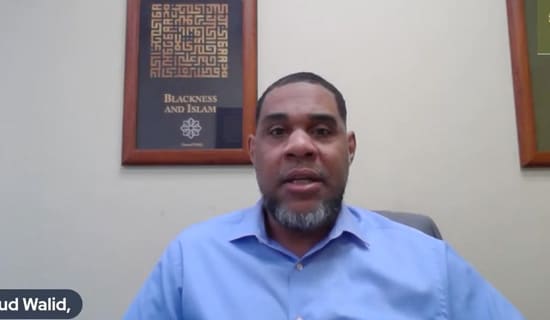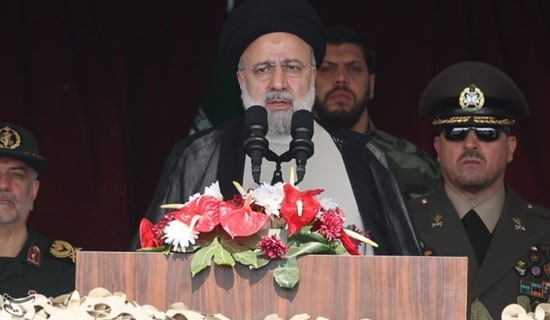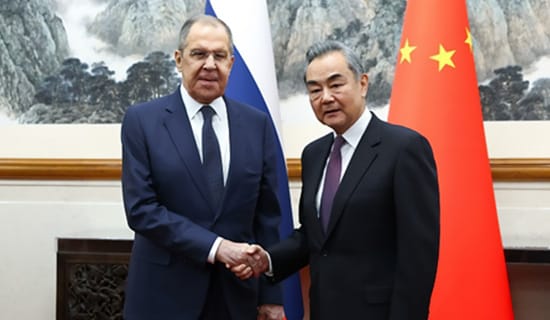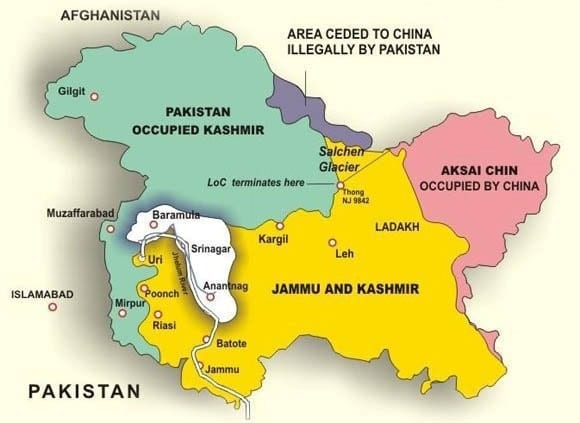
On Sunday, September 18, 2016, Pakistan-backed terrorists launched a dawn attack on an Indian military logistic base in the Uri township of Kashmir. In this attack, 18 Indian soldiers were killed, as were the four suicide bombers. Investigations revealed that this group was affiliated to the Jaish-e-Mohammed (JeM) group based in Bhawalpur, Pakistan. JeM has been involved in a number of attacks in India in the past, one of the most recent being the Pathankot Air Field attack in January 2016. Yet, this and other anti-India terror groups, like Hizbul Mujahideen (HuM) and Lashkar-e-Taiba (LeT) - all U.S.- and E.U.-designated terrorist organizations - continue to find safe haven in Pakistan, where they enjoy covert patronage and moral support from Pakistan's "Deep State."
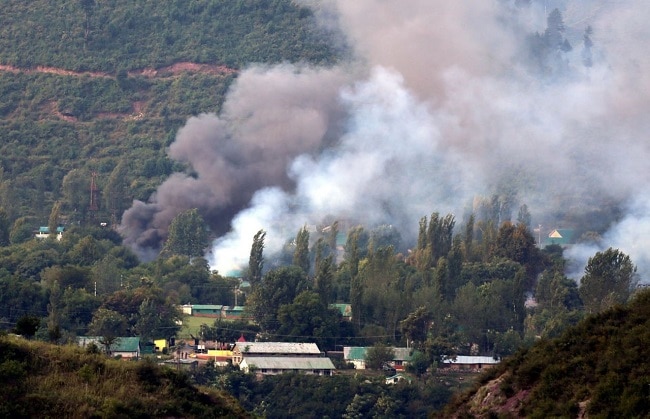
Smoke rises from the Uri Army Logistic Base, under attack. Credit: yahoo.com
An "Intifada" Movement Singes The Valley
The Kashmir Valley has been on the boil now for months, with "stone throwers" ruling the streets, reminiscent of the first Palestinian intifada. The trigger for this latest outbreak of violence was provided by the killing of a wanted Hizbul Mujahidin terrorist - Burhan Wani, a local Kashmiri, shot dead in an encounter with Indian Security Forces (SF). During Burhan Wani's funeral, in July 2016, thousands of Kashmiris poured onto the streets in a show of solidarity. Wani had been extremely successfully in mobilizing local youth to join militant movements.[1]
Many of the youth who formed the funeral procession indulged in rioting and arson, and targeted the SF. The SF found it difficult to tackle the volatile mobs who engaged in throwing stones and destruction of government infrastructure, including police stations. In the ensuing mob control measures, the SF were left with little option but to fire pellet guns in self-defense. Many of the rioters were seriously wounded, adding fuel to fire, and this aided the Hurriyat - separatists - to further incite the mobs.
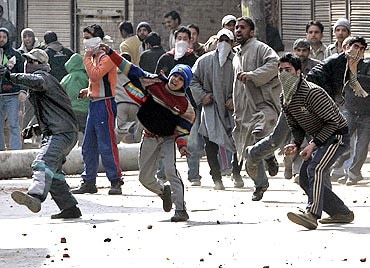
Kashmiri youth pelt SF with stones. Courtesy: rediff.com
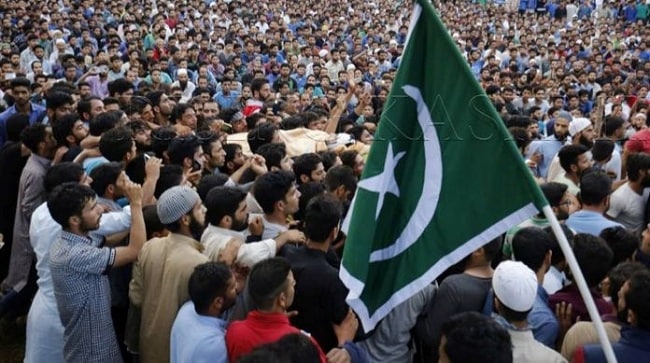
Burhan Wani's funeral procession. Credit: jandknow.com
A curfew has been in force for many weeks now, adversely impacting the life of ordinary Kashmiri citizens. Schools and colleges have been closed, and education has been a casualty. With tough restrictions in place on free movement, businesses have suffered, and tourism, a major means of livelihood, has taken a hit. From across the LoC (Line of Control), Pakistan is not letting up in its attempts to keep the Kashmir Valley in flames. People are despondent and are losing hope for an early settlement.
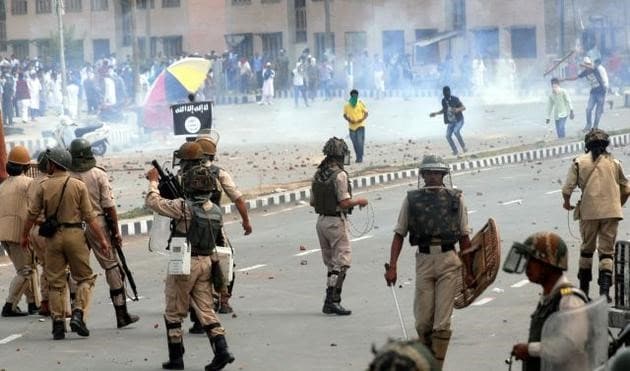
Kashmiri protestors clash with police. Photo credit: The Hindu
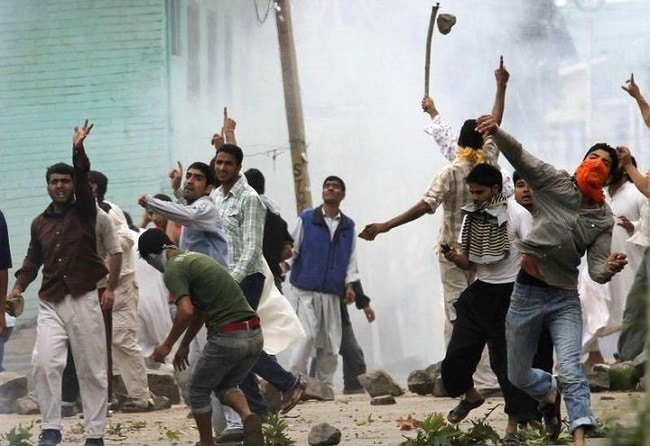
Stone throwers attack security forces. Photo credit: hillpost.in
SUPPORT OUR WORK

Infiltration attempts by terrorists, including LeT, Hizbul Mujahideen, and Jaish-e-Mohammed, have seen a marked increase in the last few months, culminating in the attack at Uri. Pakistan is instigating all this in the fervent hope that the masses of Kashmir will rise up against the Indian state to join up with Pakistan. Funds are being pumped into Kashmir, and the Hurriyat continues to be provided both overt and covert support to keep the situation boiling by instigating youth. These radicalized young Kashmiris are being provided weapons and explosives training, and are attacking the symbols of the Indian state. They seem to be just pawns, an expendable commodity for the Pakistani "Deep State" in its plan to wrest the Kashmir Valley from India.
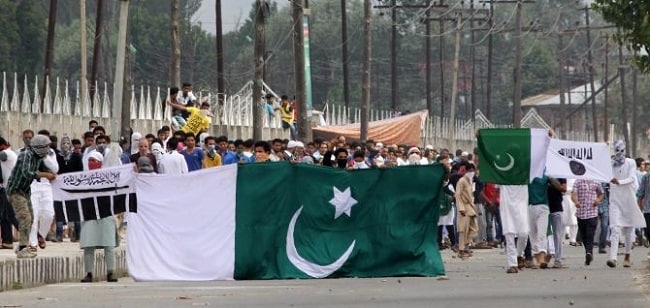
Pakistan stokes the fires. Credit: apherald.com.
Accession - The Genesis Of The Problem
At the time of partition of India and Pakistan in 1947, the Princely State of Jammu and Kashmir (J & K), a Muslim-majority state, was ruled by the Hindu Dogra ruler Maharaja Hari Singh, who was given a choice by the British to choose between acceding to one of the two countries. The Maharaja could not decide, and hoped to remain independent.
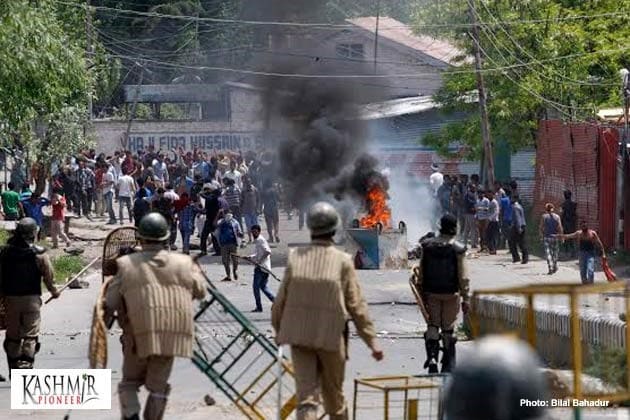
Arsonists clash with police. Credit: Kashmir Pioneer
In October 1947, Kashmir was invaded by Pashtun tribesmen from North West Frontier Province and Waziristan, supported by Pakistan Army Regulars. They began looting and plundering the state. Maharaja Hari Singh panicked and asked for help from India to defend Kashmir and push back the raiders. The Indian Army entered Kashmir at the behest of the Maharaja, who signed the Instrument of Accession when the Pashtun invaders and Pakistani regulars threatened the capital Srinagar itself. He thus merged his state with India. The Indian Army, after hard-fought battles, forced the tribesmen and Pakistan Army to withdraw from large parts of the Valley. Of course, Pakistan did not accept this accession, and immediately contested it. It claimed that the Maharaja had signed it under duress, and that he had no right to sign this accession as the "standstill agreement of J & K" with Pakistan was still in place.
In early 1948, India sought a resolution of the Kashmir conflict in the UN. A United Nations Commission for India and Pakistan (UNCIP) was set up, and the Security Council passed Resolution 47 on April 21, 1948, and brokered a ceasefire between the two neighbors. The ceasefire resulted in a temporary border between India and Pakistan, referred to as Ceasefire Line, now the Line of Control (LoC), and this divided the state into two parts. Pakistan was unable to reconcile with this adversity, and therefore fought three more futile wars to wrest Kashmir by force, and suffered defeat at the hands of the Indian Army.
In 1988, Pakistan launched a proxy war in Kashmir, codenamed Operation Topac. As part of this effort, it initiated and supported militancy in the Valley by training and arming Kashmiri youth. Simultaneously, through a well-planned conspiracy, Pakistan also commenced replacing the more tolerant Islamic Sufi culture prevalent in Kashmir with the more radical Salafi Islam. The growth of Salafi mosques and madrasas on the Kashmiri landscape changed the mindset of certain sectors of Kashmiri youth. This militancy was converted into a Pakistan sponsored proxy war backed by jihadi terror, with the active involvement of the Pakistani Army and ISI - the "Deep State" - and many Afghan Mujahidin were infiltrated into Kashmir. The Indian Army deployment, therefore, had to be strengthened to fight the designs of an inimical neighbor.
The Current Crisis In Kashmir
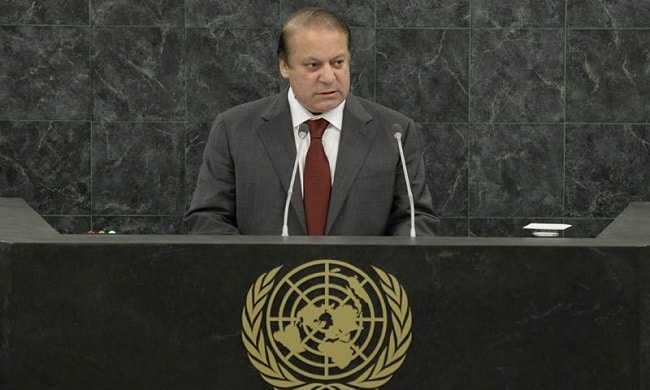
Pakistani Prime Minister Nawaz Sharif addresses UNGA. Courtesy: The DAWN
In an article recently published in the periodical India Legal, Inderjit Badhwar, a leading journalist and analyst, took on a misguided left-wing lawyer activist to clarify that Pakistan has "no feet to stand on" as regards its claims in Kashmir.[2] He noted: "The problem is between Delhi and the people of Kashmir and not between India and Pakistan. Pakistan has no role to play in this except that of a bloodstained mischief-maker into whose hands Indian governments and politicians have stupidly played into since 1948."
Badhwar quoted an old article he wrote in 1990 which stated that the uprising today is similar to past turmoil with a major difference: "But today, the movement is dominated by the money provided by Pakistan and Saudi Arabia and the muscle power of the pro-Pakistan, fundamentalist Jamaat-i-Islami and its Hizbul Mujahideen and Allah Tiger terror groups. The Jamaat is supposed to be strong in Baramula and Sopore and the 'secular' JKLF in Srinagar and Anantnag. But this is now merely semantics. For what once used to be a mass movement for the preservation of ethnic identity, of Kashmiriyat, of which Article 370 was supposed to be the symbolic guardian, has been consumed by a fundamentalist fury that gives the movement sustenance and spiritual guidance. The liberal spirit of Sufism that had so infused the valley has now been exorcised."
The reality of Kashmir today is of a struggle for legitimate rights within India distorted and made deadly by foreign interference and ideological manipulation. In this sense, the latest violence is only a continuation of efforts at subversion seen since at least the 1990s, but with a danger that it may finally become, as Burhan Wani wished and strove for, much more of a local affair.
*Deepinder Singh is a retired Indian Army Major General and a member of MEMRI's Board of Advisors.
Endnotes:


